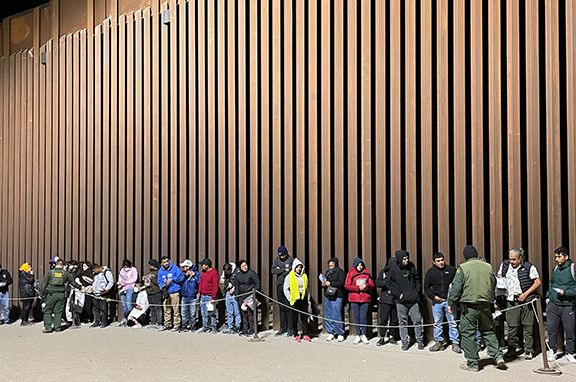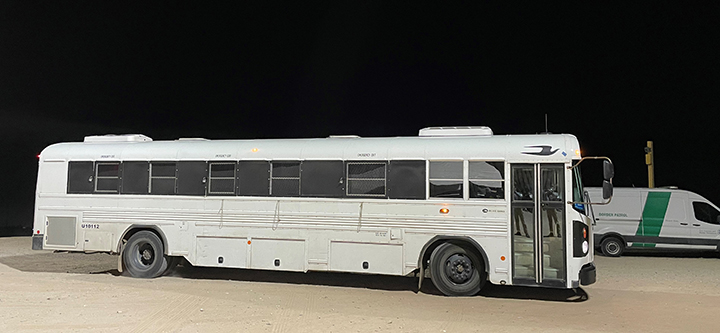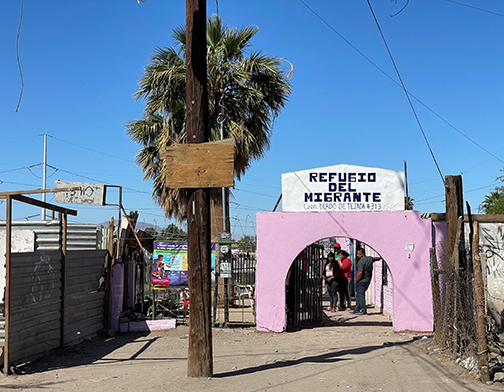
A strange and destructive thing is happening at the border. The federal government is quietly abetting human smuggling, setting off an unprecedented wave of migration.
In just over two years, the Biden administration has released more than two million illegal aliens into the United States. Another 1.3 million have entered by evading the Border Patrol. Millions more are en route. Nearly all are exploited by the cartels, which control the smuggling routes and have grown large and powerful enough to challenge governments. Some of the migrants are trafficked, assaulted, abandoned, even tortured to death. It is a deepening crisis with serious social, economic, fiscal, and political implications. But first it is a humanitarian disaster, enabled by a federal government whose primary task is to prevent such things.
The Center has extensively covered this ongoing crisis, explaining in great detail the decisions made by the administration that triggered the record surge in migration and its subsequent reactions to the surge that have made the situation worse.
The explanation for these decisions is complex. Crudely simplified, those in charge are driven by an aversion to any policy enacted by the Trump administration. Undergirding this sentiment is a growing conviction that any restriction on immigration is immoral, an idea that has taken years to germinate and is far more entrenched than mere political disagreement. It is a disturbing and revolutionary idea that threatens the stability of the nation itself. And it is now embraced by a significant number of academics and politicians, particularly on the left, including many in the administration.
Given the radical nature and general unpopularity of such a position, the unquestioned right to come to the United States is being recognized under the guise of establishing “a humane, orderly, and safe immigration system”. By broadening the definition of asylum and the widespread use of parole, for example, the administration is maintaining the illusion of order while releasing millions of illegal migrants into the country.
The architects of these policies seem unfazed by the human suffering that has ensued. For example, the administration has lost contact with 85,000 children who recently crossed the border unaccompanied. Only about 37 percent of unaccompanied children are reunited with a parent and many end up working in dangerous jobs that violate child labor laws. Despite the scope and severity of this problem, the White House has ignored repeated warnings.
Just last week, my colleague Jessica Vaughan testified at a congressional hearing on the surge of unaccompanied children. At that hearing, Department of Health and Human Services whistleblower Tara Lee Rodas revealed how the federal government has become the middleman in a vile multibillion-dollar trafficking operation. She told the committee that migrant children are being sold for sex and into debt bondage. She said there are apartment buildings where 20, 30, or 40 children are released and people who are simultaneously sponsoring children from multiple refugee sites using different addresses. She talked of enslaved Guatemalan children who can only speak Mayan dialects, unable to cry for help in Spanish or English. She pleaded for Congress to intervene.
For the current administration, it seems that the alienation and exploitation of tens of thousands of children is an acceptable trade-off for unrestricted immigration.
We saw glimpses of this mentality in action on our recent border tour. During an early morning visit to where the border wall ends in Yuma, on the edge of the Cocopah Reservation, we witnessed migrants from all over the world enter from Mexico and line up along the wall. Roughly 90 percent of the migrants that cross there are coming from countries other than Mexico. Piles of trash, including discarded passports and personal items, filled a gully just across the border. Every night hundreds, sometimes even thousands, arrive at that spot, bused on the Mexican side by smugglers who instruct them to head straight to the Border Patrol. American buses then take the migrants to a CBP tent facility, where they are fed and cared for. Most are promptly released into the United States, few questions asked. The juxtaposition of the orderly procession around the wall, erected just a few years ago, into the waiting buses prompted one of our guests to exclaim, “Our country is having a nervous breakdown!”

Behind the veneer of order lies chaos. At capacity, the Yuma tent facility costs more than a million dollars a day to operate. The local hospital has provided $20 million in uncompensated care to migrants in just the last few months. The produce industry in Yuma, which provides nearly all of the lettuce consumed in the United States and Canada in the winter months, has been forced to implement time consuming and expensive measures to prevent E. coli contamination, which is at an elevated risk due to the steady stream of migrants that hike through the lettuce fields, sometimes relieving themselves. And then there is the drug trafficking, which has become easier to do since Border Patrol agents are now busy greeting migrants. Jonathan Lines, a Yuma county supervisor, told us that every family in the area knows someone who has been harmed by fentanyl. The tragedies of the opioid epidemic are mounting.
To the west, San Diego Sector Chief Aaron Heitke told us that his agents are now apprehending around 1,000 migrants a day, sometimes in groups of 200 or 300. Each migrant pays a smuggling fee of $8,000 to $10,000 to get through on land or $10,000 to $15,000 to enter by boat via the Pacific. Every inch of the border is controlled by the cartels, and crossers who do not pay are severely punished. Border Patrol agents often care for migrants in desperate situations and sometimes even deliver babies. This year they have already seen 157 nationalities. Heitke said that when they release a migrant from a given country into the United States, a lot more people from that country start arriving. He also told us that his agents have seized 1,000 pounds of fentanyl in the last two months.
Just south of the border, in the Mexican city of Mexicali, we visited three bustling migrant shelters filled with people from all over the world who have responded to Biden’s La Invitacion. Unlike shelters we visited on previous trips, the three in Mexicali are not run by Christian churches and are at least loosely affiliated with the UN’s International Organization for Migration. One of the shelters lacked a roof and was in extreme disrepair. The man who was in charge, whom we had arranged to meet, was fired before our visit when it was discovered that he was profiting off of smuggling. In another shelter, which was crammed with people, dozens of children came out of their rooms to greet us. What will become of all these migrants is unknown.

The surge, however, is expected to get even bigger as Title 42 is set to expire this month. The public health order that allows expedited removal is still being used to deport a fraction of the migrants who are apprehended. The San Diego Sector, for example, sends back under Title 42 about 25 percent of the migrants they encounter. When that order expires, those deportations will no longer occur. There is a growing queue of migrants stretching deep into Central America, all waiting for the change in policy before they make their way to the United States.
One story from our trip stands out against the chaos and suffering of the surge. Our guide in Mexicali was a young man who migrated illegally to New Jersey as a teenager. After making the decision to leave his family, he was fortunate to find stable foster care and attend high school in the states. After high school, he worked at odd jobs and, for whatever reason, was one of the rare illegal aliens who got noticed by Immigration and Customs Enforcement and was deported. Recalling the experience, he told us that he made the decision not to illegally reenter the United States. Instead, he has established himself in Mexicali, enterprising and successfully employed with a family of his own. He explained that so many migrants force their way into the United States in search of the American dream, but often their stories do not have a happy ending. The current policies of our federal government almost ensure that this is so.
